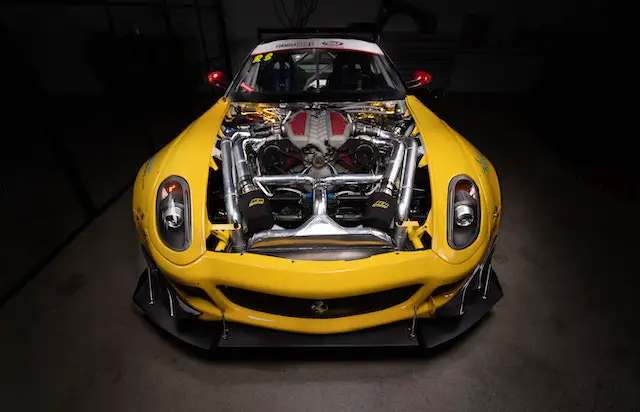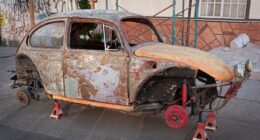Torque is a measure of rotational force that enables a vehicle to move from a standstill or climb steep inclines, while horsepower refers to the speed at which work is done.
What is torque?
(Image by Gerhard Rohrer from Pixabay )

Torque is a term used to describe the force that causes an object to rotate around its axis or pivot point. It can be thought of as the twisting force applied to an object, such as a wheel or a bolt. To better understand torque, picture yourself trying to open a jar lid that is tightly screwed on. You’ll need to apply some amount of force (torque) in order for the lid to twist and come off.
Torque is measured in units called Newton-meters (Nm) or pound-feet (lb-ft). The value of torque depends on two factors – the distance from the axis of rotation where the force is being applied and the magnitude or strength of that force.
In vehicles, torque plays a crucial role in determining their performance. Engines with high torque produce more power at lower speeds, which translates into faster acceleration and towing capacity. This makes them suitable for heavy-duty applications like trucks and SUVs.
Understanding what torque means helps us appreciate how it affects machines’ ability to perform specific tasks efficiently.
What is horsepower?
(Photo by Leif Bergerson)

Horsepower is a term that’s commonly associated with engines and vehicles, but what exactly does it mean? Simply put, horsepower refers to the amount of power an engine can produce. It was first coined by James Watt in the 18th century when he needed a way to compare the output of steam engines to that of horses.
In technical terms, one horsepower is equal to 745.7 watts or 550 foot-pounds per second. This means that an engine with a higher horsepower rating will be able to deliver more power than one with a lower rating.
However, it’s worth noting that while having more horsepower generally means better performance, other factors such as torque and weight also play important roles in determining how well a vehicle performs.
Understanding what horsepower means can help you make informed decisions when it comes to choosing vehicles or evaluating their performance.
Torque Vs. horsepower – Key differences
Torque and horsepower are two important concepts in the automotive industry, but they have different meanings. Torque is a measure of rotational force that an engine generates, while horsepower is a measure of how quickly work can be done. The key difference between torque and horsepower lies in their units.
Torque is measured in pound-feet (lb-ft) or Newton-meters (Nm), whereas horsepower is measured in watts or horsepower (hp). Torque allows you to accelerate faster from a lower speed, which makes it ideal for towing heavy loads or driving on steep hills. Horsepower, on the other hand, allows you to maintain higher speeds over longer distances.
Another key difference between torque and horsepower is where they occur in the RPM range. Torque occurs at low RPMs while horsepowers occurs at high RPMs. An engine with high torque but low power will feel more responsive when accelerating from a standstill because it provides more initial force.
In contrast, an engine with low torque but high power will be able to maintain higher speeds over long distances but won’t have as much acceleration off the line. Ultimately both are equally essential and necessary for optimal performance depending on what needs to be accomplished by the vehicle’s output under specific circumstances
How are torque and horsepower related?
Torque and horsepower are two different measurements of power in an engine, but they are still closely related. Torque is the force that causes rotational motion, while horsepower determines how quickly work can be done based on torque.
In simpler terms, you need torque to get things moving, and horsepower to keep things moving fast. The higher the torque produced by an engine, the more work it can do over a shorter period of time. This means that engines with high amounts of torque will feel more powerful at lower speeds.
On the other hand, horsepower measures how much work can be done over a longer period of time. It’s essentially a measure of sustained effort rather than quick bursts of energy like torque provides.
While these two measurements may seem unrelated at first glance, they actually go hand-in-hand when it comes to engine performance. A well-designed engine will have both high levels of torque for quick acceleration and sufficient horsepower for sustained speed over long distances.
How do you calculate torque?
Calculating torque involves two variables: force and distance. The formula for torque is the product of the force applied and the distance from the pivot point where it’s being applied. In other words, torque = force x distance.
To calculate torque accurately, you must know how much force is being exerted on an object perpendicular to its axis of rotation. This can be achieved using a device called a torque wrench that measures rotational force in foot-pounds (ft-lbs) or Newton-meters (N-m).
Once you have determined the amount of force applied, multiply that by the distance between where the force was applied and where it acts around an axis to find out how much rotational energy is produced by that application.
It’s important to note that different types of machinery require different levels of torque. For instance, cars need more torque than motorcycles because they are heavier and carry more weight.
In summary, calculating torque requires knowledge about both forces involved as well as their respective distances from each other so that we could determine just how much rotational energy will be generated when these forces come together at any given point in time!
How do you calculate horsepower?
Calculating horsepower is relatively simple once you know the equation. Horsepower can be calculated using torque and RPM. In fact, this formula is often used by mechanics to determine the amount of power an engine produces.
To calculate horsepower, you first need to understand what torque is and how it relates to horsepower. Torque measures rotational force produced by a car or machine’s engine. On the other hand, horsepower measures how much work an engine can do over time.
The formula for calculating horsepower looks like this:
Horsepower = (Torque x RPM) / 5,252
In order to use this formula, you will need to know both the torque output of your engine and its revolutions per minute (RPM). Once you have those two figures in hand, simply plug them into the equation above and solve for horsepower.
It’s worth noting that there are many factors that can influence an engine’s performance beyond just its raw power output. Factors such as weight distribution, transmission gearing and aerodynamics all play a role in determining how fast a car or machine can go based on its given level of horsepower.
Examples of torque
Torque is a measure of the twisting force that an object can produce. It’s essential in various everyday applications, from turning screws to riding bicycles and driving cars. To better understand torque, here are some examples:
One example of torque is when you use a wrench to tighten or loosen bolts on a car engine. The force applied by the wrench creates a rotational force that produces torque.
Another example of torque is when you ride your bike uphill. Pedaling harder will increase the amount of torque produced by your legs and help you move up the hill faster.
In manufacturing, machines like lathes and drills rely heavily on torque to function correctly. These machines have motors with high-torque output to rotate their cutting tools at high speeds.
Torque also plays an important role in sports where throwing or hitting balls requires significant muscle strength, like baseball, football or golfing.
These are just a few examples of how we encounter torque in our daily lives without even realizing it! Torque has countless practical uses across several industries and fields – whether for hobbyists working on DIY projects or professionals using heavy machinery- making it essential for us all to understand its basic principles.
Examples of horsepower
Examples of horsepower can be seen all around us, from the cars we drive to the machines used in manufacturing. One common example is the internal combustion engine found in most vehicles. The horsepower of a car’s engine determines its speed and acceleration capability.
For instance, a high-performance sports car might have 500 or more horsepower, allowing it to go from 0-60 mph in just a few seconds. On the other hand, an economy car may only have 100-150 horsepower and take several more seconds to achieve that same speed.
Another example of horsepower can be found in industrial machinery such as tractors or bulldozers which require significant power for their heavy-duty tasks. These machines often come equipped with powerful engines capable of producing hundreds or thousands of horsepower.
In addition, electric motors are also rated by their horsepower output. For instance, an electric motor powering a treadmill may have anywhere between one and five horsepower depending on its size and intended use.
Examples of horsepower can be seen across industries and applications where power is necessary for performance and productivity.
Photo by Spencer Davis








